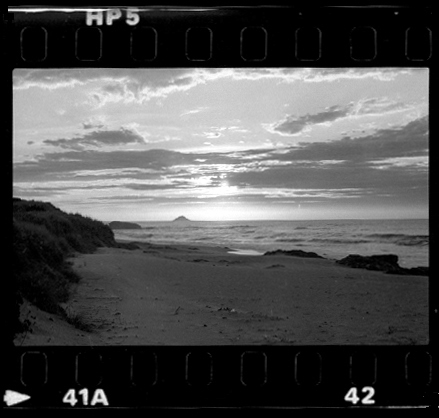
|
This series
of works originated from the ritual of my many early morning walks along the beaches
near my house at Brighton. Often I would walk the shifting sands and the schist rocks,
with a camera, where I would watch the patterns of waves breaking, the
patterns of tide marks, the patterns of clouds across a rising sun. Always far out in the ocean was pyramidal form of Green Island rising
above the skyline. While the images I took were interesting, I always
had a deep feeling inside there was more to this place and the ritual
of my walking that I had not yet discovered. Initially I used a 35mm camera
and then around 1996 I began using a 6x6 cm camera. |
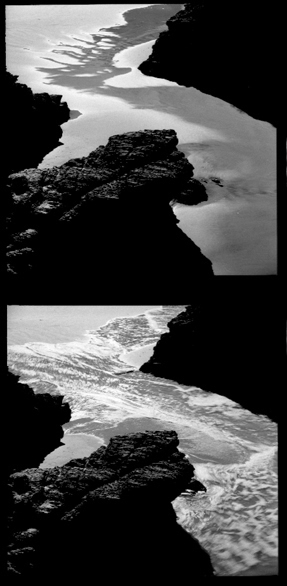
Lloyd Godman 11/4/1987
|
When I began using a 6X6 cm format camera that offered a larger negative size and consequently
more detail, it also offered a different frame format to design
the image in. It had the tyranny of the symmetrical nature of the
square rather than the rectangle of the 35mm format to deal with.
I became fascinated with the nature of time and space and experimented
with image sequencing within the symmetry of the square. |
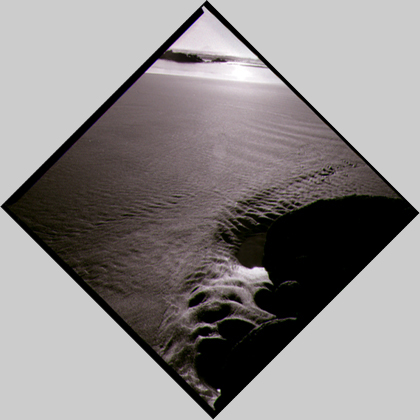
Lloyd
Godman 1/2/1988 |
The
stability and balance that a level horizon line gives a photographic
image is often an essential part of the design. I had learned that horizons
that slightly tilt can produce a sense of awkwardness in an image and
if the image is to be taken on a lean it should look deliberate
and be at least 15-20° off line. |
|
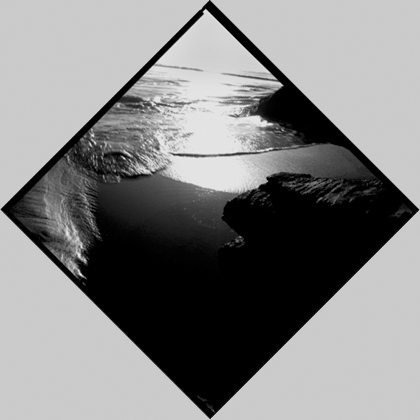
Lloyd
Godman 1/2/1988 |
I
soon developed the idea of deliberately tilting the camera on a 45 degree
angle to create lozenge or diamond shaped image, with the island in the
corner of the frame, but positioning the camera in such a manner
so as the square frame was balanced on the fulcrum became a difficult
task, and was even more unforgiving. The visual potential of the images
became evident but it so did the need to adequately solve the problem
of a level horizon line.
|
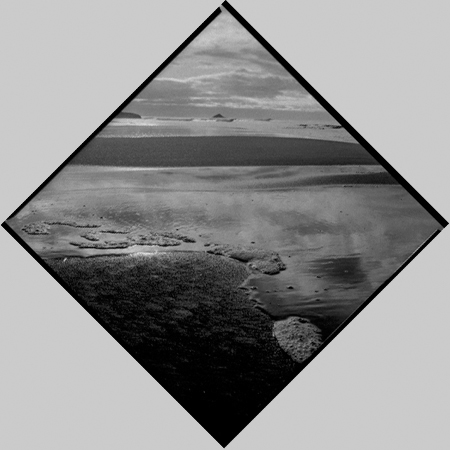
Lloyd
Godman 78 degrees east 7.48am 17/10/188 |
Eventually
I made a small device with a level that fitted on the side of the
camera which allowed me to very quickly set up the camera on a tripod,
level the camera and lock it in position on a tripod. I became conscious
of the angle of the sun in relationship to the island and began recording
the time the images were taken and the compass bearing through the
island to the sun.
|
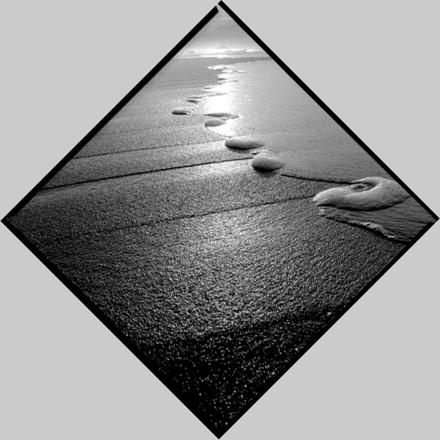
|
As I
spent more time taking photographs using this method, it became obvious
that the furthest position I could shoot from and still keep the sun
and the apex of the Island in axis, was on the longest day or summer
solstice. And from here the idea of a summer solstice sojourn was
born, where I would photograph the sun in axis with the island as
it rose from the ocean and traversed across the sky. |
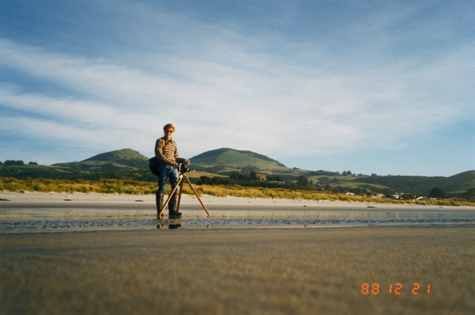
Lloyd Godman
during the first Summer Solstice 1988 |
Solstice Works
is an extensive a series of Photographic
Journeys based on the summer Solstice. Over a number of years, during the week of the summer
solstice, I would devote a whole day to following the traverse of
the sun across the sky and landscape from dawn to dusk. Sometime this
would involve following the light of the sun, other times it would involve
following a shadow.
From each journey a sequence of photographs was created where the date, time, compass bearing etc. was recorded along side the images. The strategy of image sequence where light and shadow alter, also appeared in earlier work on the Clutha River from 1983-4 and may other projects including Dam Shadow, St Andrews, Victoria, Australia 2009.
The play with the hyperbole of space that is revealed in the Solstice sequences is also a consistent strategy used in many other projects like diVISION.
|

Lloyd Godman during the
Bull Creek Summer Solstice 2002 |
During the
summer solstice the sun is at its zenith, it is balanced on a fulcrum
before it tips back towards the winter solstice. As a play on the fulcrum,
Godman orientates the frame of a 6x6 cm format camera, on a diagonal with
a 90 degree angle at the top and bottom. Often the sun or other pointers
are located in the upper or lower apex. Sometime the sun is referenced
below as a reflection, other times it dances high across the vaulted sky.
For some
journeys the sky is clear and cloudless, at others the journey is interpreted
by cloud and rain. |
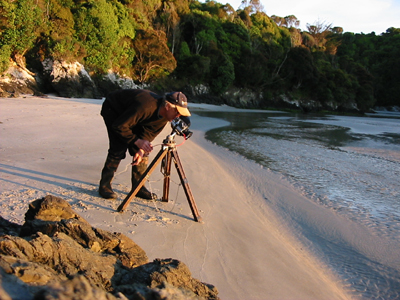
Lloyd Godman during the Bull Creek Summer
Solstice 2002 |
Like all
previous Solstice journeys the square format camera was tipped
onto a diagonal to produce a lozenge shaped image. The solstice is a time
of balance when the sun has reached its zenith and is about to tip back
towards winter. |
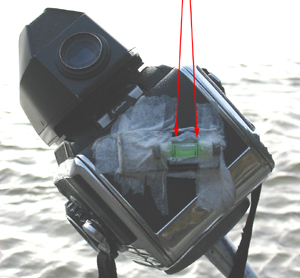 |
By taping a level to the
camera back it is quick and easy to position the camera frame on the diagonal.
|
| |
In 2006 I saw La Naissiance
du Soleil 1973-4, a work by Barbara and Michael Leisgen
at the Centre Pompidou Daep, Paris, where they had worked with a series
of photographs of the rising sun.
|
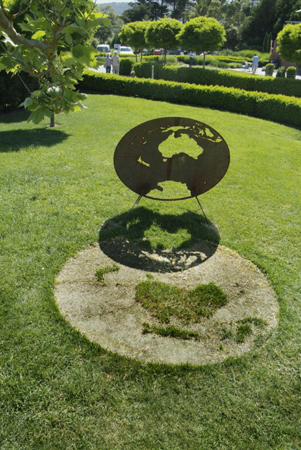 |
The rotation of the sun and shifting patterns of light and shadow also appear in other works - in Planet III, a steel dish with a map of the globe cut out of it projected a shadow onto a similar map grown into the grass. As the sun rotated the shadow interacted with the image on the grass. |
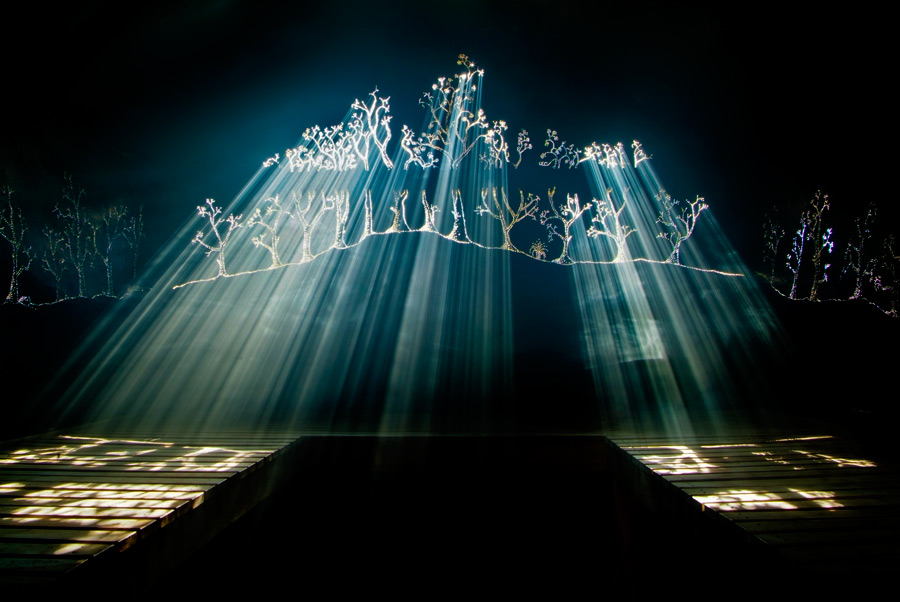 |
The Carbon Obscura work in 2007 also exploited the rotation of the sun across the sky - the light projections of the sun through the thousands of pinholes rotated across the ground and even up the walls. |
| |
2008
Recently I have begun to look at the movement of the sun across the sky as a metaphor for a human life. As every day is different so is every life. There is some influence here from ALFRED STIEGLITZ (1864–1946)

Equivalent (Series), 1925-1931
"Stieglitz photographed clouds from 1922 into the thirties. A symbolist aesthetic underlies these images, which became increasingly abstract equivalents of his own experiences, thoughts, and emotions. The theory of equivalence had been the subject of much discussion at Gallery 291 during the teens, and it was infused by Kandinsky's ideas, especially the belief that colors, shapes, and lines reflect the inner, often emotive "vibrations of the soul." In his cloud photographs, which he termed Equivalents, Stieglitz emphasized pure abstraction, adhering to the modern ideas of equivalence, holding that abstract forms, lines, and colors could represent corresponding inner states, emotions and ideas." Adapted from Eye, LBW
As a day might begin in sunshine an end in rain so might a life. While another day might begin with clouds and thunder and end in sunshine. Still another may be changeable with periods of sun, cloud wind and rain. How we equate sunshine and rain raises another issue. We might look at this from different positions: from fame, or fortune, or emotional, or physiological, or spiritual perspectives.
From Arthur Zajonc's book Catching the Light, it was interesting to read of Prometheus, whom I had encountered in the Mythology of Place, work, and Heracles - he concludes " The shared, cultural imagination of man as sojourner in a dark fallen world into which light has been mingled --- " page 46
Each Solstice Journey becomes a traverse from darkness into light and back towards the darkness again -
|